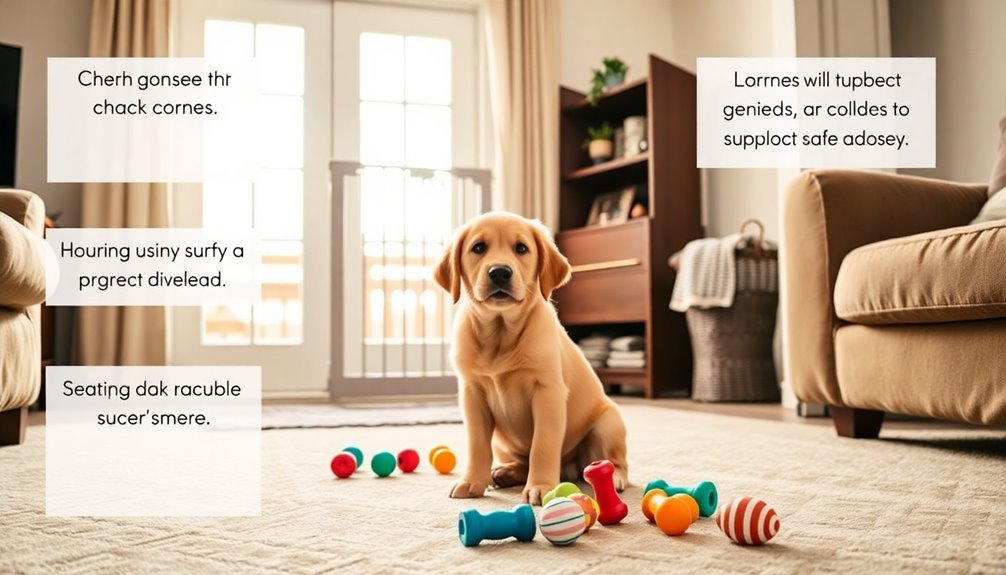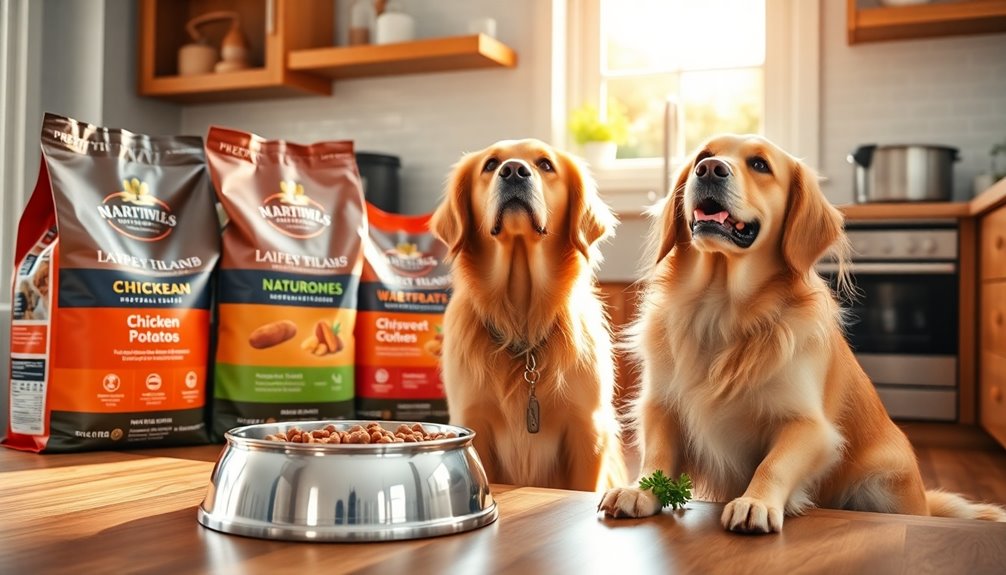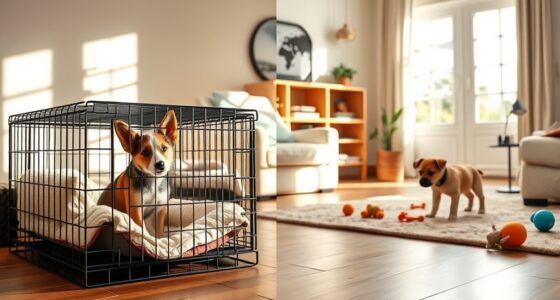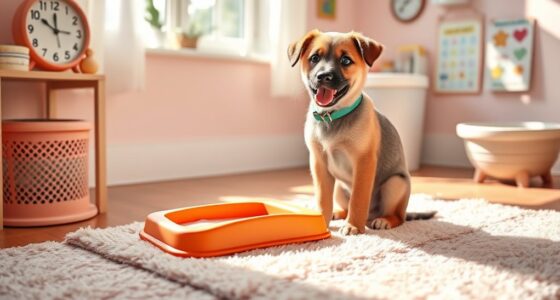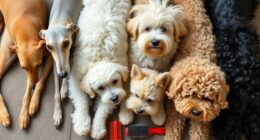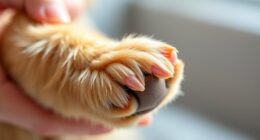To puppy-proof your home, start by locking away hazardous substances and keeping human food secure in sealed containers. Install childproof latches on cabinets and guarantee toilet lids stay down. Stow away cords to prevent chewing and protect prized possessions by moving them out of reach. Create safe interactions with existing pets gradually. Don't forget your yard; verify it's secure and free of hazards. Regularly inspect your space for potential risks. These ten easy steps will keep your puppy safe and happy. Stick around to find even more tips for a secure and joyful puppy environment!
Key Takeaways
- Secure hazardous substances by locking them away in cabinets or high shelves to prevent accidental poisoning.
- Store human food in sealed containers and use childproof locks on cabinets to keep toxic items out of reach.
- Install childproof latches on cabinets and designate safe areas for puppy playtime, free from dangerous items.
- Remove toxic plants from your home and replace them with pet-friendly alternatives to ensure a safe environment.
- Conduct regular safety inspections around the home and yard to identify and mitigate potential hazards for your puppy.
Lock Away Dangerous Substances
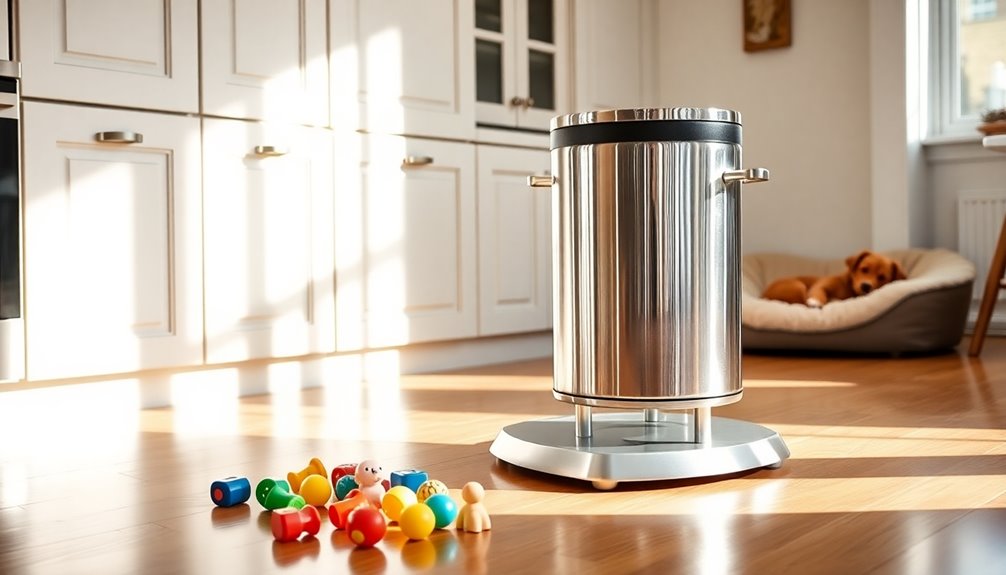
When bringing a puppy into your home, you need to lock away dangerous substances to keep them safe. Puppies are naturally curious and may explore areas that contain toxic household items, like cleaning products, medications, and personal care products.
To prevent accidental poisoning, it's crucial to secure these items in locked cabinets or on high shelves.
Be especially cautious with aerosol sprays, lotions, perfumes, and anything in handbags, as these can contain harmful substances. Mouse and rat poisons pose a significant risk too, so make sure they're removed from your home before your new puppy arrives.
Regularly check storage areas to confirm that all dangerous chemicals are securely locked away and out of reach.
Educating everyone in your household about the importance of this step is imperative. It helps create a safer environment for your puppy and minimizes the risk of accidental poisoning.
Close Off Cabinets
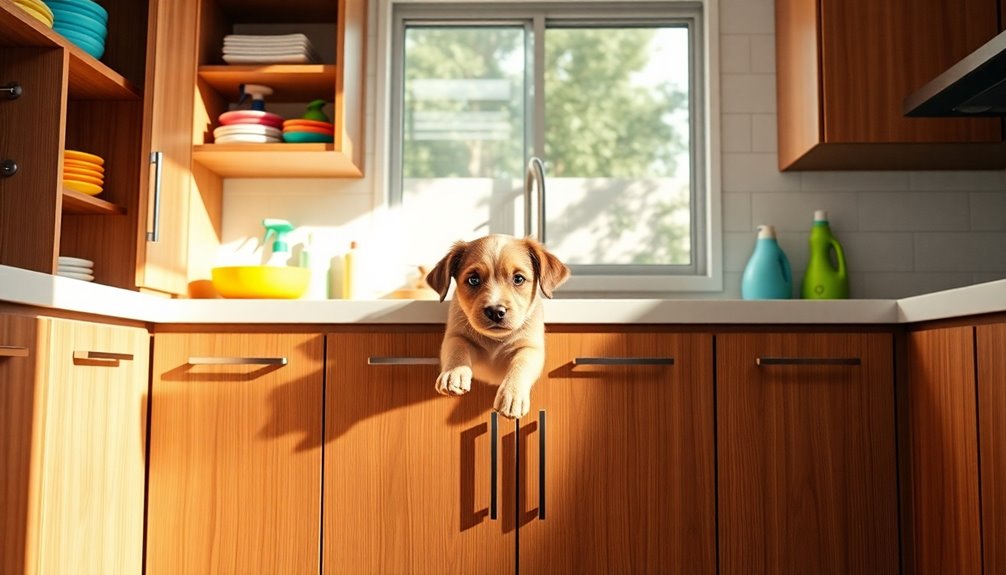
How can you guarantee your puppy's safety while exploring your home? One essential step is to close off cabinets.
Start by installing childproof latches on all cabinet doors. This simple action prevents your curious pup from accessing harmful cleaning supplies and household chemicals that can pose serious health risks.
Designate specific cabinets for pet food and treats, ensuring they've secure closures. This helps avoid overindulgence or potential poisoning from unsafe items.
Regularly check that all cabinets remain closed, as puppies can easily open those without secure latches, leading to unexpected hazards.
Pay special attention to low cabinets where medications and other dangerous items may be stored. Make sure these are either locked or placed out of reach.
Additionally, consider using decorative storage boxes or baskets on shelves to keep small, enticing items away from your puppy. This reduces the chance of accidental ingestion and keeps your furry friend safe. Incorporating safety measures for children in your home can also provide a safer environment for pets.
Keep Toilet Lids Down
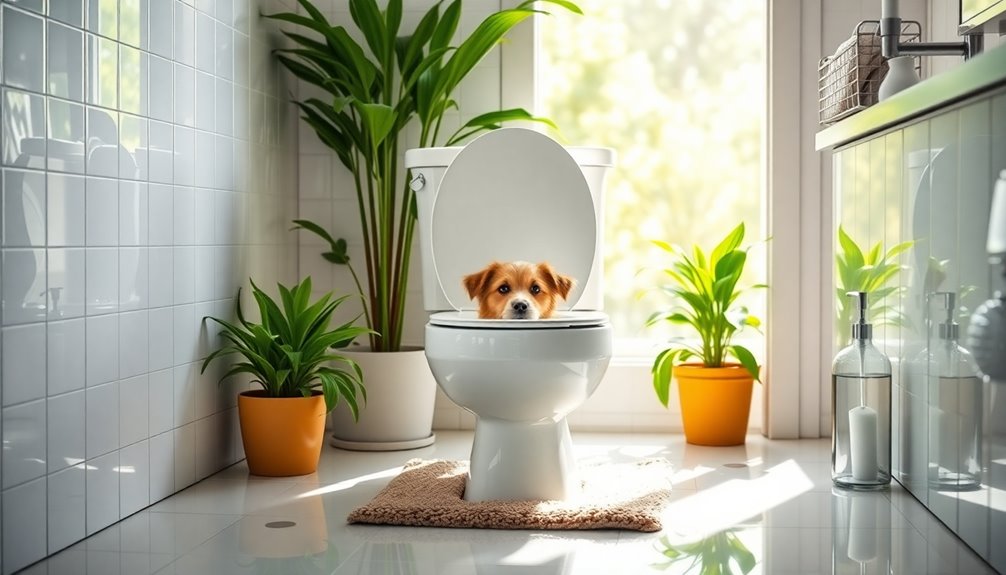
Keeping toilet lids down is essential for your puppy's safety, as it prevents access to harmful bacteria and cleaning chemicals.
Make it a habit for everyone in your home to close the lids after use, and provide a designated water bowl to encourage your pup to drink safely.
Prevent Bacterial Exposure
One simple yet effective way to prevent bacterial exposure in your home is by always keeping toilet lids down. Curious puppies are naturally inclined to explore their surroundings, and a toilet can seem like an intriguing source of water. However, this can lead to accidental ingestion of harmful cleaning chemicals or bacteria like E. coli and Salmonella, which can cause serious gastrointestinal issues.
To create a safer environment, train everyone in your household to consistently keep toilet lids closed after each use. This simple habit minimizes the risk of your puppy accessing these dangerous areas.
Additionally, providing a designated water bowl filled with clean water can help reduce your puppy's temptation to seek alternative sources, like the toilet.
Regularly monitoring this habit and reinforcing it can establish a routine that protects both your puppy and your home's hygiene. Remember, a little diligence goes a long way in preventing bacterial exposure.
Designated Water Bowl
Providing a designated water bowl is vital for guaranteeing your puppy stays hydrated and safe. This bowl should be filled with fresh, clean water at all times, giving your puppy a reliable source to drink from.
It's important to establish this routine early, as it helps your puppy develop safe habits and reduces the temptation to seek out unsafe drinking sources, like the toilet.
Keeping toilet lids down is essential in puppy-proofing your home. Puppies can easily access the toilet, which may contain harmful bacteria and cleaning chemicals.
By consistently closing the lids after use, you create a safer environment for your puppy. Make it a habit for all family members to follow this rule, reinforcing safe habits around the home.
Regularly check and refill the designated water bowl to guarantee it remains an appealing option for your puppy. A familiar water bowl not only promotes hydration but also helps your puppy feel secure in their space.
Train Family Members
To guarantee your puppy's safety, it's essential that everyone in your household understands the importance of keeping toilet lids down. Puppies are naturally curious and may try to drink from toilets, exposing themselves to harmful substances like bacteria and cleaning chemicals. This can lead to serious accidents and injuries, so you need to train family members to make this a priority.
Start by establishing a household routine that includes closing toilet lids after each use. Make it a fun challenge for kids, turning it into a game where they get points for remembering. Remind everyone that a simple action can create a safer environment for your puppy.
In addition to keeping toilet lids down, providing a designated water bowl will further deter your puppy from seeking water in unsafe places. Reinforce this training consistently, ensuring the message sticks.
Stow Away Cords

Since puppies are naturally curious and love to explore their surroundings, stowing away cords is crucial for keeping them safe. Untangling and neatly organizing your electrical cords using cord management solutions like clips or sleeves can help prevent them from chewing on them. Chewing on cords can lead to serious electrical hazards or burns, so it's essential to take precautions.
Here are some tips to puppy-proof your cords:
- Use sturdy cord covers to provide extra protection against curious puppies.
- Secure cords to walls or furniture with electrical tape to keep them out of reach.
- Store remote controls and other small electronic devices in high, secure locations.
Regularly inspect your cords for fraying or damage, as worn cords pose greater risks. Investing in chew-proof cord covers can be a smart choice for additional safety. Additionally, it's important to consider the weight of vacuum cleaners, as lighter models can be easier to maneuver when cleaning up any mess your puppy may create.
Keep Human Food Secure
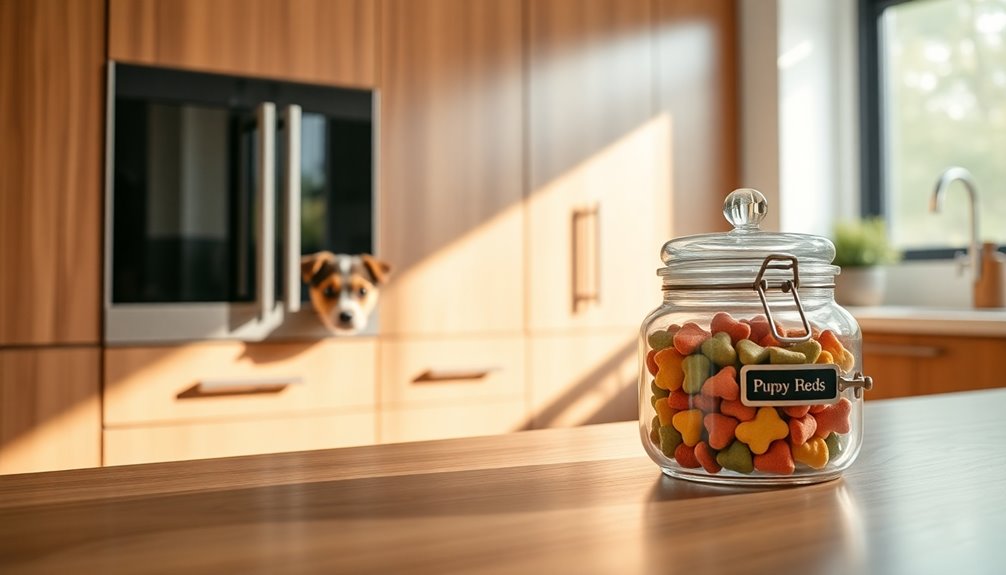
Keeping your puppy safe means securing human food in your home.
Make sure to store food in sealed containers, stay aware of toxic foods, and keep trash cans tightly closed.
Food Storage Solutions
When it comes to puppy-proofing your home, securing human food is essential for your furry friend's safety. Proper food storage helps you keep toxic items away from curious pups. Start by storing all human food in sealed containers or cabinets that are out of reach. This way, you can prevent your puppy from accessing harmful items like chocolate or grapes.
To enhance your food storage solutions, consider these tips:
- Use childproof locks on kitchen cabinets to secure snacks and pantry items.
- Keep trash cans in cabinets or opt for lidded bins to deter scavenging.
- Regularly clean countertops and dining tables to eliminate any unattended food.
Educate family members and guests about the importance of puppy proofing by ensuring they know to clean up after meals and store food securely. Remember that some common foods like grapes are toxic to dogs, so it's crucial to be vigilant about what is accessible to them.
With these strategies in place, you can minimize the risk of your puppy getting into unsafe items, keeping them safe and healthy while enjoying their time at home.
Toxic Food Awareness
Puppies are incredibly curious, and it's vital to be aware of the dangers posed by human food. Certain toxic items, like chocolate, grapes, and xylitol in sugar-free products, can lead to severe health issues if ingested.
To prevent accidental ingestion, always monitor your kitchen counters and tables for unattended food. Use sealed containers for snacks, ensuring your puppy can't access them.
Store human food and treats in high cabinets, and consider using child-proof latches on lower cabinets to keep them out of reach. It's important to secure trash cans with tight-fitting lids, as puppies love to scavenge and might find harmful food scraps that could cause choking or poisoning.
Make sure everyone in your household is educated about the dangers of leaving food unsupervised. Establish clear boundaries for where your puppy is allowed during meal times.
Trash Can Safety
Trash cans can be a treasure trove of danger for your curious puppy, making it imperative to secure them properly. Puppies are notorious for rummaging through trash, and the potential harmful human food they might find can be toxic to dogs.
To guarantee trash can safety, follow these simple steps:
- Use trash cans with secure lids or childproof locks to prevent access.
- Store trash cans inside cabinets to eliminate temptations.
- Regularly empty and clean cans to remove enticing food odors.
In addition to these precautions, consider compost bins with secure lids to avoid accidental ingestion of spoiled food.
Establishing a consistent training routine is also vital; teach your puppy that rummaging through the trash is off-limits. Reinforcing these boundaries not only keeps your puppy safe but helps promote safety in your home.
Remove Toxic Plants
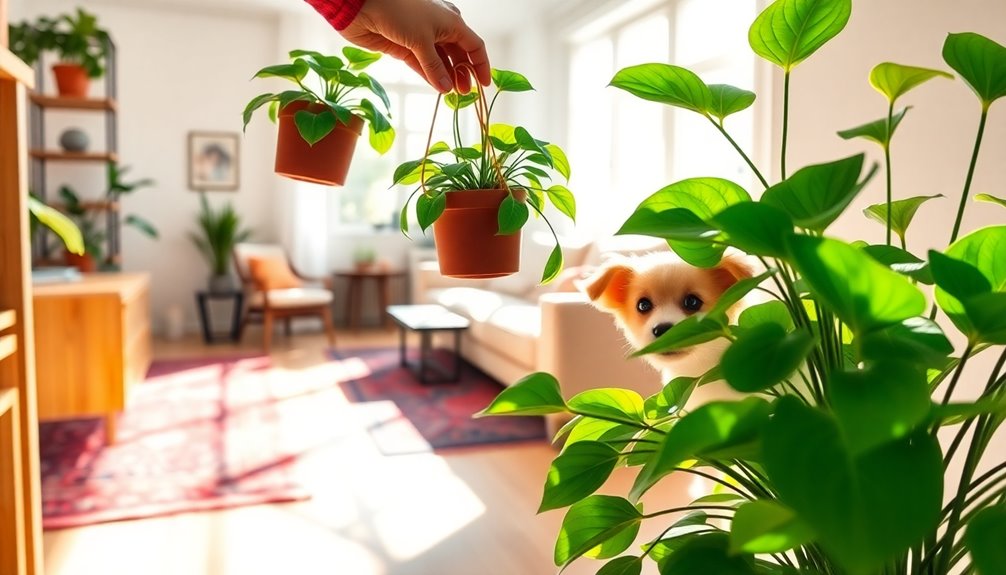
If you're a dog owner, it's crucial to guarantee your home is free from toxic plants that could endanger your furry friend.
Start by identifying common toxic plants like Sago palm, Castor bean, lilies, and hydrangeas. Even small amounts of certain plants, especially those in the lily family, can lead to severe health reactions or even be fatal to dogs.
It's important to consult the ASPCA's list of toxic and non-toxic plants to confirm your indoor and outdoor greenery is safe.
Regularly check your home and yard for new plants, particularly if you receive gifts of flowers or plants. Remember, some plants can sneak into your environment without you realizing their potential danger.
To create a safe environment for your puppy, consider replacing toxic plants with pet-friendly alternatives. Options like spider plants or Boston ferns are great choices that won't harm your dog. Additionally, keeping your puppy's diet in mind, high-quality protein sources can support their overall health and well-being, ensuring they thrive in a safe space.
By proactively removing toxic plants and opting for safe alternatives, you'll help confirm your home remains a welcoming and secure space for your furry companion.
Prioritizing your dog's safety will give you peace of mind as they explore their new home!
Protect Prized Possessions
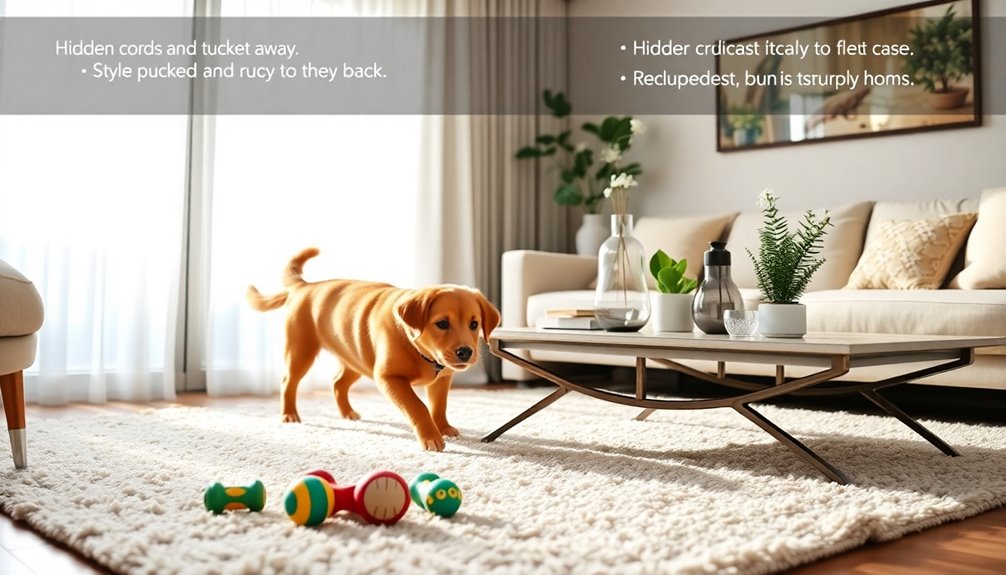
To keep your prized possessions safe from your curious puppy, start by storing items out of reach.
Providing chew toys can redirect their attention and prevent them from targeting your belongings.
You might also consider using taste deterrents on furniture to discourage unwanted chewing.
Store Items Out of Reach
How can you keep your prized possessions safe from your puppy's curious nature? The key is to store items out of reach.
Puppies are naturally inquisitive and will chew on anything they can access, which means your valuable items need protection.
Here are some effective strategies:
- Use closed closets: Securely store personal items like handbags and shoes.
- Utilize high shelves: Keep electronics and harmful materials like medications and cosmetics out of reach.
- Install hooks: Hang jackets or bags that could be tempting chew toys for your pup.
Additionally, be aware that some common household plants, like chrysanthemums, can be toxic to dogs and should be kept out of reach as well.
Provide Chew Toys
Providing chew toys is vital for protecting your prized possessions while keeping your puppy happy and engaged. By offering appropriate chew toys, you can redirect your puppy's natural chewing instincts away from your furniture and valuables, reducing the risk of destructive behavior.
Choose durable chew toys made from non-toxic materials to guarantee safety and withstand your puppy's strong bite, especially if they're teething.
To maintain your puppy's interest and engagement, regularly rotate the chew toys. This helps prevent boredom and the temptation to chew on inappropriate items. Introduce a variety of textures and shapes to cater to your puppy's preferences, enhancing their overall chewing experience while providing mental stimulation.
While your puppy plays with their chew toys, it's important to supervise them. This guarantees they're using the toys correctly and prevents accidental ingestion of small parts or damage.
Use Taste Deterrents
Taste deterrents, like bitter apple spray or citrus-based solutions, can be a game-changer in puppy-proofing your home. By applying these safe, pet-friendly sprays to your furniture and prized possessions, you can greatly reduce your puppy's urge to chew on items you want to protect.
Remember to consistently monitor your puppy's behavior and reapply the deterrent after cleaning or if your pup shows renewed interest in previously treated items.
To effectively use taste deterrents, consider the following tips:
- Combine with chew toys: Provide appropriate chew toys alongside deterrents to redirect chewing behavior toward safe items.
- Rotate toys regularly: Keeping a variety of chew toys can engage your puppy and reduce their desire to seek out prohibited items.
- Be persistent: It might take some time for your puppy to learn, so stay committed to the process.
Prepare Other Pets
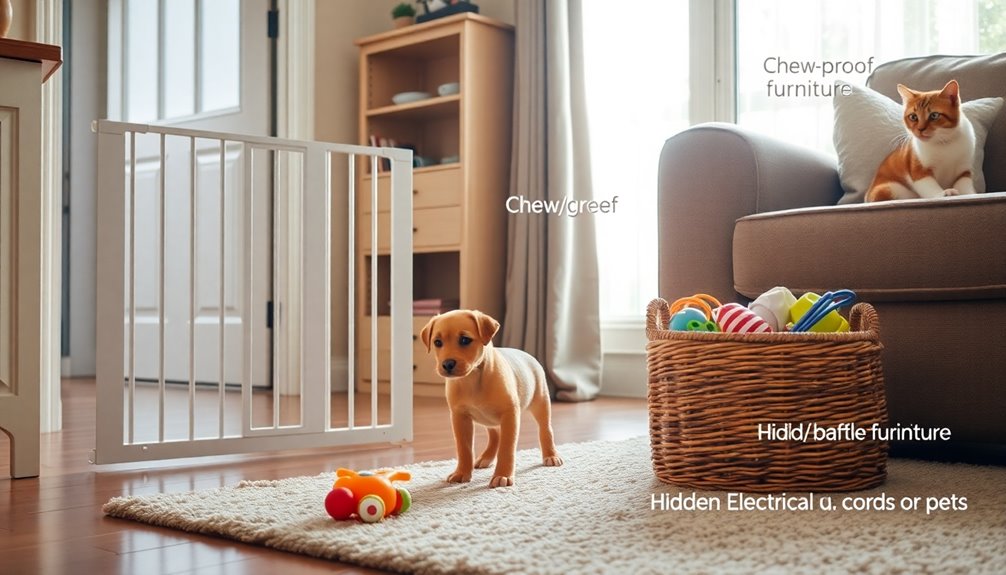
When welcoming a new puppy into your home, preparing your other pets is essential for a smooth changeover. Start with gradual introductions to reduce stress and potential conflicts. Research proper techniques to help your existing pets acclimate to the new arrival.
Begin by allowing them to get familiar with each other's scents without direct contact. Ensure that all cages and tanks for your other pets are secure and inaccessible to the new puppy. This step protects both your existing pets and the puppy from accidental harm or escape.
During the initial interactions, supervise closely to monitor behavior, stepping in if necessary to keep the peace. Establish safe zones where your existing pets can retreat if they feel overwhelmed. These spaces should be off-limits to the puppy, allowing your pets to feel secure.
Gradually increase the time spent together, focusing on positive reinforcement to create a friendly environment. Consistent training and boundaries are essential during this phase to ensure a harmonious household.
Dog-Proof the Yard
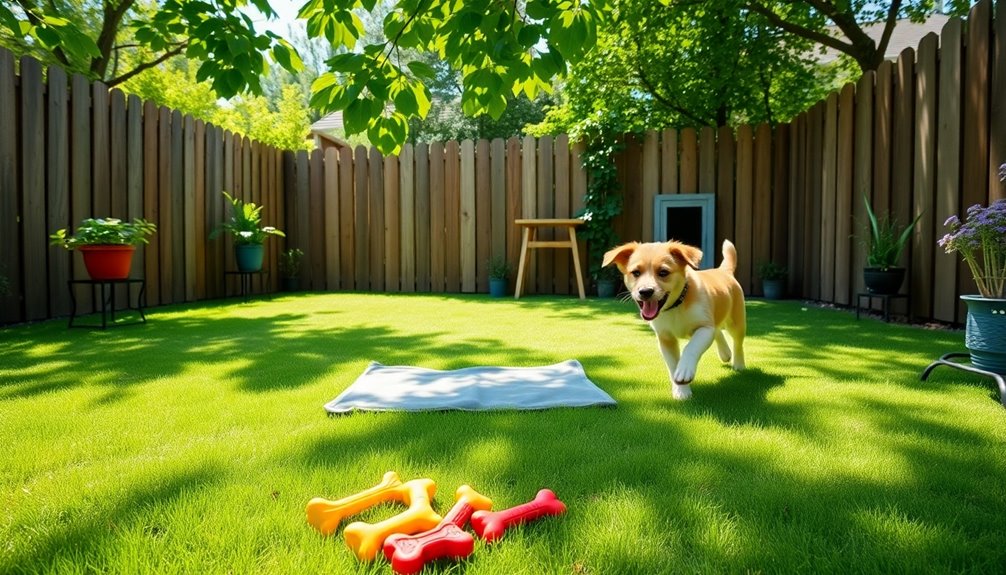
Dog-proofing your yard is fundamental to keeping your new puppy safe and happy. Start by evaluating your yard for potential hazards. Look out for sharp objects, toxic plants like Sago Palm and Castor Bean, and unsecured gardening tools that could harm your puppy.
Here are some vital steps to take into account:
- Install or Update Fencing: Make sure your fencing is at least six feet high and check for any gaps or holes your puppy could squeeze through.
- Designate a Bathroom Area: Encourage proper elimination habits by designating a specific bathroom area in the yard, which also makes cleanup easier.
- Regular Inspections: After storms or weather changes, regularly inspect the yard for new hazards like fallen branches or debris that could pose a risk.
Additionally, keep in-ground pools securely fenced to prevent drowning risks. Store all chemicals used in the yard, such as fertilizers and pesticides, safely out of reach.
Secure the Garage
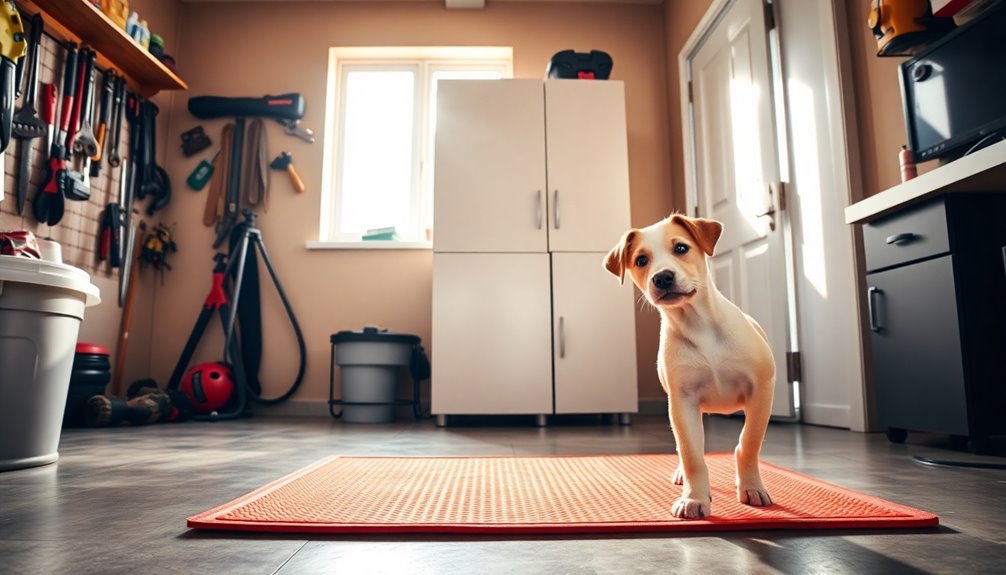
After ensuring your yard is safe, it's time to focus on the garage, another area that can pose hidden dangers for your puppy. Start by securing hazardous chemicals like antifreeze and motor oil in locked cabinets to prevent accidental ingestion. Immediately clean up any spills to eliminate slip hazards and reduce the risk of toxic exposure.
Keep sharp objects, such as tools and blades, out of reach and securely stored. Regularly check the garage for new potential hazards, like loose wires or forgotten items, that could pose risks as your puppy explores. Designate a safe area within the garage for puppy playtime, ensuring it's free from any dangerous items or chemicals. Additionally, be aware that some plants, like chrysanthemums, can be toxic to dogs if ingested, so it's important to keep them out of the garage as well.
Here's a quick checklist to help you puppy-proof your garage:
| Action | Purpose | Reminder |
|---|---|---|
| Store chemicals securely | Prevent accidental ingestion | Lock cabinets |
| Clean up spills | Eliminate slip hazards | Use absorbent materials |
| Store sharp objects away | Prevent injuries | Use storage bins |
| Inspect for hazards regularly | Keep the garage safe | Do this weekly |
Frequently Asked Questions
How Do You Dog Proof a Home?
To dog-proof your home, start by securing hazardous substances in locked cabinets or high shelves.
Use childproof latches to keep food and toxic items out of reach.
Remove any poisonous plants and relocate them away from your dog's access.
Cover electrical cords to prevent chewing, and monitor areas for choking hazards like small objects or unsecured trash cans.
These steps help create a safe environment for your furry friend to explore.
What Not to Do When Bringing a Puppy Home?
When bringing a puppy home, don't neglect their environment.
Avoid leaving hazardous substances accessible or failing to secure dangerous items.
It's essential not to overwhelm them with too many new experiences or people at once.
Inconsistent training can lead to bad habits, so stick to a clear approach.
Finally, don't ignore their socialization needs; exposing them to various environments and sounds is important for their development and confidence.
How Long Does It Take for a Puppy to Get Used to Your House?
Think of your puppy like a new plant in a garden; it needs time to adapt to its surroundings.
Generally, it takes a few days to several weeks for a puppy to settle into your home. By establishing consistent routines and creating a safe space, you'll help your puppy feel secure.
Plus, socializing with family and engaging in positive interactions will build trust, accelerating the adjustment process and making your pet feel truly at home.
How to Puppy Proof Outlet?
To puppy-proof your outlets, start by using outlet covers or safety plugs to block any unused sockets.
You might also consider tamper-resistant outlets that close automatically when not in use.
Keep electrical cords tucked away or use cord management solutions to prevent your puppy from chewing them.
Regularly check for wear or damage, and educate everyone in your home on the importance of keeping outlets and cords out of reach.
Safety comes first!
Conclusion
By taking these steps, you're setting your home up for success in welcoming your new puppy. Just like a knight wouldn't charge into battle without armor, don't let your guard down when it comes to safety. Remember, it's not just about keeping your pup safe today; it's about ensuring a happy, healthy environment for years to come. So, roll up your sleeves and get to work—your furry friend will thank you for it!

